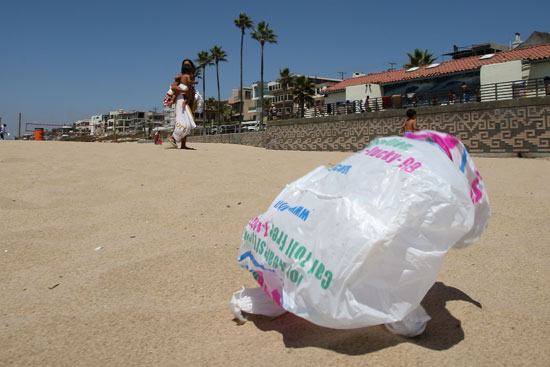Betting on a shore thing
September 19, 2013

With plastic bag bans taking hold across the state, officials say our beaches are becoming beneficiaries.
At the end of each summer, the beach gets a close-up.
On the annual Coastal Cleanup Day, which occurs again on Saturday, thousands head to beaches and watersheds to pitch in during what’s billed as the largest volunteer event in the world. The junk they collect provides a troubling snapshot of how some of our bad habits can affect the environment.
During last year’s cleanup, a whopping 516,798 pounds of debris was collected statewide. The biggest offender was cigarette butts, accounting for 217,423 pounds, or 42 percent of the total. But plenty of other stuff was collected, too, including 94,182 pounds of food wrappers and containers, 43,783 pounds of plastic bags, 1,159 pounds of condoms, 1,187 pounds of six-pack holders and 508 pounds of syringes. You get the idea.
In L.A. County alone, 43,427 total pounds of debris was picked up last year, despite a volunteer turnout that was significantly reduced by triple-digit temperatures.
Still, the numbers offer a ray of hope. Eben Schwartz, who organizes the statewide volunteer push for the California Coastal Commission, said plastic bags, which take hundreds of years to decompose, are declining in jurisdictions that have enacted restrictions.
“In San Francisco, bags are way down the past couple of years,” Schwartz said.
Bans on single-use plastic bags started in the Bay Area around 2007 and are now banned throughout Alameda County. L.A. County banned plastic bags in 2010, but the ordinance only applied to county facilities and unincorporated areas, representing a small slice of the region’s total population. Other jurisdictions have since followed suit. In June, the City of Los Angeles got on board with an ordinance that will take effect next summer.
“On future cleanup days,” Schwartz predicted, “there’s going to be a whole lot less plastic bags in Los Angeles.”
Officials say that other government measures appear to be having an impact, too, including bans on Styrofoam containers and the installation of storm-drain screens to catch debris. The amount of trash collected statewide during Coastal Cleanup Day 2012 was just 12 pounds per person, down from 19 pounds in 2011, 15 pounds in 2010 and 17 pounds in 2009.
Over the past decade, catch basin screens have been installed in storm drains throughout L.A. County, said Kerjon Lee, spokesperson for the county’s Department of Public Works. The basins block trash from entering inland waterways and reaching the ocean.
Further downstream, Lee said, trash booms are deployed after rain storms to catch debris that has made it down flood channels and rivers. “They are good systems but they are end of the pipe systems,” Lee said of the booms. “It’s kind of a last, valiant effort to prevent debris from entering water bodies.”
Meanwhile, public health initiatives, such as banning smoking on the beach, have also had a positive impact on the on the environment, reducing trash on the sand and in the water, Lee said.
But not everything can be caught before it hits the water, and that’s where Coastal Cleanup Day comes in. The event began in Oregon in 1984. Nine years later, it had entered the Guinness Book of World Records as the “largest garbage collection.” The event has now spread to 35 states and nearly 100 countries. Here in L.A. County, both inland and at the coast, 11,000 volunteers will fan out on foot, on kayaks and even in wetsuits and scuba gear.
Liz Crosson, executive director of Los Angeles Waterkeeper, organizes a yearly scuba cleanup around “Hyperion Pipe,” which sends L.A.’s treated waste water miles out to sea. The structure that holds the pipe in place catches a lot of trash that enters the ocean. “I am amazed at what they pull out of there,” Crosson said. “They get pounds and pounds of plastic bags.”
Heal the Bay has been the lead organization for L.A. County’s Coastal Cleanup Day since 1990. Marissa Maggio is coordinating the event for the nonprofit environmental group.
“You can notice a difference; there’s definitely less debris at certain beaches,” said Maggio, who hopes to inspire people year round. “It would be great if every time you went to the beach, you bring a bucket and glove and pick up a little trash.”
Posted 9/19/13












 405 bridge work causes a stink
405 bridge work causes a stink
